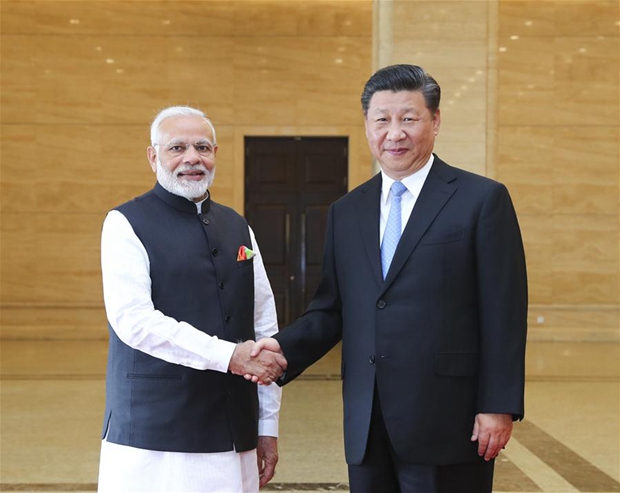Xi-Modi meeting: A preview
- By Sajjad Malik
 0 Comment(s)
0 Comment(s) Print
Print E-mail China.org.cn, April 28, 2018
E-mail China.org.cn, April 28, 2018

Chinese President Xi Jinping (R) and Indian Prime Minister Narendra Modi visit an exhibition of cultural relics at Hubei Provincial Museum in Wuhan, capital of central China's Hubei Province, April 27, 2018. [Photo/Xinhua]
The informal meeting between President Xi Jinping and Indian leader Narendra Modi is a bold endeavor to put the ties between their respective countries on an even keel after the disturbing Donglang (Doklam) standoff last year, which offset the relationship between the two giant neighbors.
The 73-day confrontation was an eye-opener. The soldiers at one point were throwing stones and punches, and it could have easily spiraled into a limited war or even a major conflict. But good sense prevailed and the two sides decided to de-escalate without trying to gain any immediate territorial advantage.
China, being far superior militarily, could have used its power to overrun Indian positions but it rightly held its nerve. Despite achieving military objectives, China would have suffered a loss to its soft image, as India would have emerged as a victim and used its position to gain global sympathy.
To the credit of India, it also held its nerve and refused to blink despite apparently not being in any position to defeat China. It also ignored calls from right-wing elements in the government and establishment to act tough.
The incident shows that unsettled boundary issues can result in unexpected conflagrations. Even if armed conflict is avoided, the acrimony can last a longtime and negatively impact bilateral cooperation in different fields, including trade and economy.
The meeting between Xi and Modi is in fact a realization on the part of both neighbors that war is not a solution to any issue. It has been proven umpteen times.
China in particular is carefully cultivating its peaceful rise as an economic and military power and has some major goals to achieve in coming years and decades. The most immediate is to create a moderately prosperous country by 2021, which coincides with the centenary celebration of the founding of the Communist Party of China. The second, and even bigger, target is to build a truly socialist society by 2049.
For Chinese leadership it is important to stay on track to fulfill these achievements on time instead of wasting energy on distractions. But it does not mean that China is willing to compromise its sovereignty. There is consensus that it will not yield to any kind of highhandedness, whether relating to the issue of sovereignty on the South China Sea or with Taiwan or to territorial disputes with India.
India's story isn't very different. But it should tame its chauvinistic aspirations and also avoid war, which would severely damage its current development. Any kind of military situation would be a blow to the dream of transforming the country into a greater India.
Another issue related to India is that it has hitched itself to the United States' bandwagon and is indirectly playing a part in the strategic great game whose rules and objectives are determined in Washington. One of the key components of the game is to contain China by economic, military or strategic means. Hence, any confrontation between India and China would serve some of the objectives of this game.
Apart from the long term goals of Xi-Modi meeting, India also needs China for issues like NSG membership and tackling terrorism and militancy. It is also not happy with the China-Pakistan Economic Corridor (CPEC), which is a flagship project of Belt and Road Initiative and a symbol of deepening cooperation between Pakistan and China.
China has already rejected India's point of concern on CPEC. This means India will have to come around to understanding that the initiative is for regional development. It is better for it to support it, as CPEC will not remain limited to Pakistan. Already Iran has shown interest in joining. CPEC is also likely to be expanded to Central Asia, and even the Middle East.
The informal meeting is expected to go well. China is hosting the SCO summit in June and would like that the top leadership of its members, including India, attend the meeting. Understandings reached between the two leaders will pave the way for another meeting on the sidelines of the SCO.
Another positive aspect is that Xi and Modi know each other well, as they have met six times since their first meeting in 2014, when Xi visited India. Their last meeting was in September 2017, when Modi visited China to attend the BRICS summit.
Sajjad Malik is a columnist with China.org.cn. For more information please visit:
http://www.china.org.cn/opinion/SajjadMalik.htm
Opinion articles reflect the views of their authors, not necessarily those of China.org.cn.






Go to Forum >>0 Comment(s)